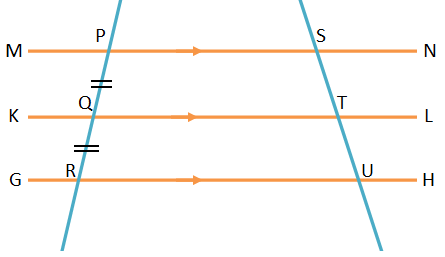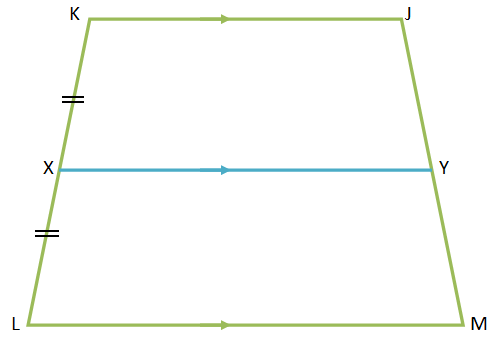Subscribe to our ▶️ YouTube channel 🔴 for the latest videos, updates, and tips.
Problems on Equal Intercepts Theorem
Here we will solve different types of problems on Equal Intercepts Theorem.
1.
In the above figure, MN ∥ KL ∥ GH and PQ = QR. If ST = 2.2 cm, find SU.
Solution:
The transversal PR makes equal intercepts, PQ and QR, on the three parallel lines MN, KL and GH.
Therefore, by the Equal Intercepts Theorem, ST = TU = 2.2 cm.
Therefore, SU = ST + TU = 2.2 cm + 2.2 cm = 4.4 cm.
2. In a quadrilateral JKLM, JK ∥ LM. A line parallel to LM is drawn through the midpoint X of KL, which meets JM at Y. Prove that XY bisects JM.
Solution:
Given: In the quadrilateral JKLM, JK ∥ LM. X is the midpoint of KL and XY ∥ LM.
To prove: XY bisects JM.
Proof:
|
Statement |
Reason |
|
1. JK ∥ LM ∥ XY. |
1. JK ∥ LM and XY ∥ LM. |
|
2. KL makes equal intercepts on JK, XY and LM. |
2. Given that KX = XL. |
|
3. JM also makes equal intercepts on JK, XY and LM. |
3. By the Equal Intercepts Theorem. |
|
4. JY = YM. |
5. From statement 3. |
|
5. XY bisects JM. (Proved). |
5. From statement 4. |
From Problems on Equal Intercepts Theorem to HOME PAGE
Didn't find what you were looking for? Or want to know more information about Math Only Math. Use this Google Search to find what you need.




New! Comments
Have your say about what you just read! Leave me a comment in the box below. Ask a Question or Answer a Question.